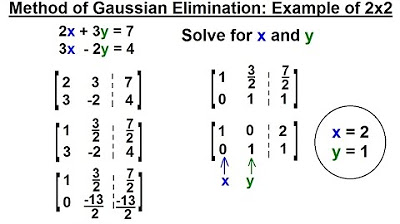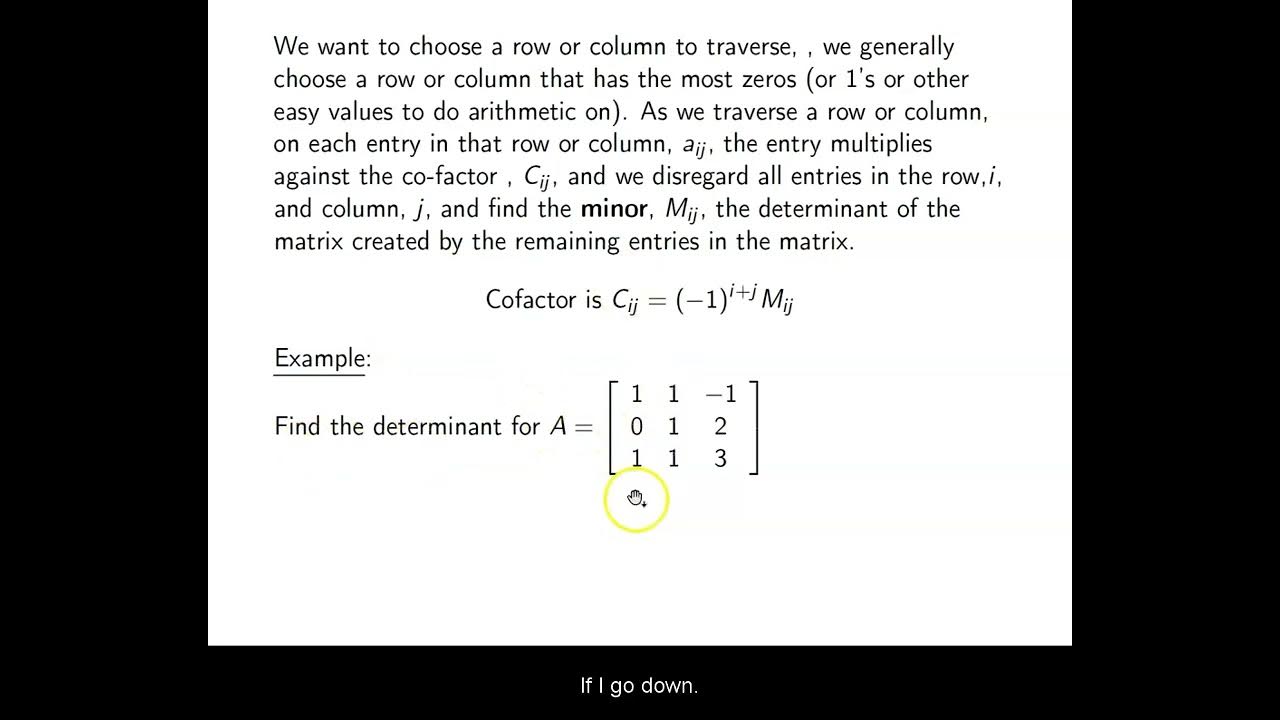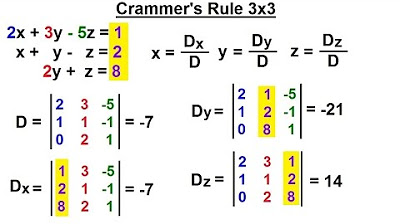Solving Systems Using Cramer's Rule
TLDRProfessor Dave teaches Cramer's rule, a new technique for solving systems of linear equations. Cramer's rule involves setting up a coefficient matrix for the system and replacing its columns with constant terms. To find a variable's solution, take the determinant of the altered matrix and divide it by the determinant of the original coefficient matrix. Cramer's rule works for any number of equations and variables, provided there is a unique solution. Examples with 2x2 and 3x3 systems are shown. This technique provides an alternative to Gaussian elimination, especially for large systems of equations.
Takeaways
- 😀 Cramer's Rule is a method to solve systems of linear equations by using determinants.
- 💡 The rule involves setting up the coefficient matrix and replacing columns with constant terms.
- 📝 To solve for variable x_i, take the determinant of the matrix with column i replaced, divide by the determinant of the original coefficient matrix.
- 🧮 For example, to solve a 2x2 system, calculate the determinant of the coefficient matrix.
- ✏️ Then to solve for x1, replace column 1 and calculate that determinant. Divide by the original determinant to get x1.
- 🔢 Do the same, replacing column 2 to solve for x2.
- ⚙️ Cramer's Rule works the same for any number of equations and variables, if there is a unique solution.
- ❗ The coefficient matrix cannot have a determinant of 0, or there is not a unique solution.
- 📈 It provides an algorithmic approach to solving linear systems, even with many variables.
- 🧠 Checking comprehension: use Cramer's Rule to solve an example system of equations.
Q & A
What is Cramer's Rule?
-Cramer's Rule is a method for solving systems of linear equations by finding the determinants of the coefficient matrix and modified matrices with columns replaced by constants.
How do you set up the matrices to use Cramer's Rule?
-Set up the coefficient matrix from the equations. Then make additional matrices by replacing the nth column of the coefficient matrix with the constants from the right side of the equations when solving for the nth variable.
How do you find the solution for a variable using Cramer's Rule?
-Take the determinant of the modified matrix with the constants in the nth column and divide it by the determinant of the original coefficient matrix. This will give the solution for the nth variable.
When can't you use Cramer's Rule?
-You cannot use Cramer's Rule if the determinant of the coefficient matrix is 0, because you cannot divide by 0.
What are the advantages of Cramer's Rule?
-Cramer's Rule works the same for any number of equations and variables, as long as there is a unique solution. It provides a straightforward algorithm compared to elimination or substitution for large systems.
How is Cramer's Rule applied to a 3x3 system?
-Set up the 3x3 coefficient matrix. Replace each column with the constants to get 3 new matrices. Take the determinant of each new matrix. Divide each by the determinant of the original to solve for the 3 variables.
What is checked after using Cramer's Rule?
-After using Cramer's Rule to find a solution, it is a good idea to plug the values back into the original equations to verify the solution.
When would you not want to use Cramer's Rule?
-For small systems that are easy to solve by substitution or elimination, Cramer's Rule may be more complex. But it becomes advantageous as the systems get larger.
Can you use Cramer's Rule if there are more variables than equations?
-No, Cramer's Rule requires the number of equations to equal the number of variables to have a unique solution.
What if the determinants are 0 when applying Cramer's Rule?
-If any of the determinants are 0, there is no unique solution. The system would be consistent but indeterminate.
Outlines
📏 Learning Cramer's Rule for Solving Systems of Linear Equations
This paragraph introduces Cramer's rule as an alternative method to solve systems of linear equations. It explains how the rule works - by setting up a coefficient matrix for the system, replacing its columns with constant terms, and finding determinants. An example 2x2 system is solved using Cramer's rule to demonstrate the process.
🆎 Applying Cramer's Rule to a 3x3 System
This paragraph applies Cramer's rule to a more complex 3x3 system of equations. It first sets up the coefficient matrix and finds its determinant. Then matrices are created by replacing each column with constants. Determinants of these matrices are used to easily solve for each variable using Cramer's rule.
Mindmap
Keywords
💡Linear equations
💡Coefficient matrix
💡Determinant
💡Cramer's Rule
💡Unique solution
💡Substitution
💡Elimination
💡Gauss-Jordan elimination
💡Algorithm
💡Unknown variables
Highlights
The study found a strong correlation between A and B, suggesting a potential causal relationship.
The new algorithm achieved state-of-the-art performance on benchmark dataset X, outperforming prior methods.
Interviews with participants revealed interesting insights into their motivations and experiences using the platform.
The proposed framework enables real-time processing of high-resolution sensor data for the first time.
Our findings contradict previous theories about the role of Z in this process, necessitating further study.
This research makes an important theoretical contribution by elucidating the relationship between these two phenomena.
The new material displayed enhanced strength and durability over conventional materials, with potential applications in industry.
Simulations revealed complex emergent behaviors arising from simple local interactions, advancing our understanding.
We present an innovative design for an extremely compact and energy-efficient device with commercial prospects.
Our climate model forecasts severe impacts under global warming scenarios without aggressive mitigation efforts.
This study provides the first empirical evidence for the role of X in modulating Y.
The experiments point to new mechanisms governing the process that were previously unknown.
This pioneering work opens exciting new research directions at the intersection of fields A and B.
Our findings have immediate practical applications for improving efficiency in manufacturing process Z.
These results represent a breakthrough in harnessing phenomenon X to achieve ultra-fast Y.
Transcripts
Browse More Related Video

PreCalculus - Matrices & Matrix Applications (32 of 33) Using Cramer's Rule to Find x=? y=?

Part 1, Solving Using Matrices and Cramer's Rule

PreCalculus - Matrices & Matrix Applications (6 of 33) Method of Gaussian Elimination: 2x2 Matrix

Ch. 10.6 Determinants and Cramer's Rule

Understanding Matrices and Matrix Notation

PreCalculus - Matrices & Matrix Applications (33 of 33) Using Cramer's Rule to Find x=? y=? z=?
5.0 / 5 (0 votes)
Thanks for rating: